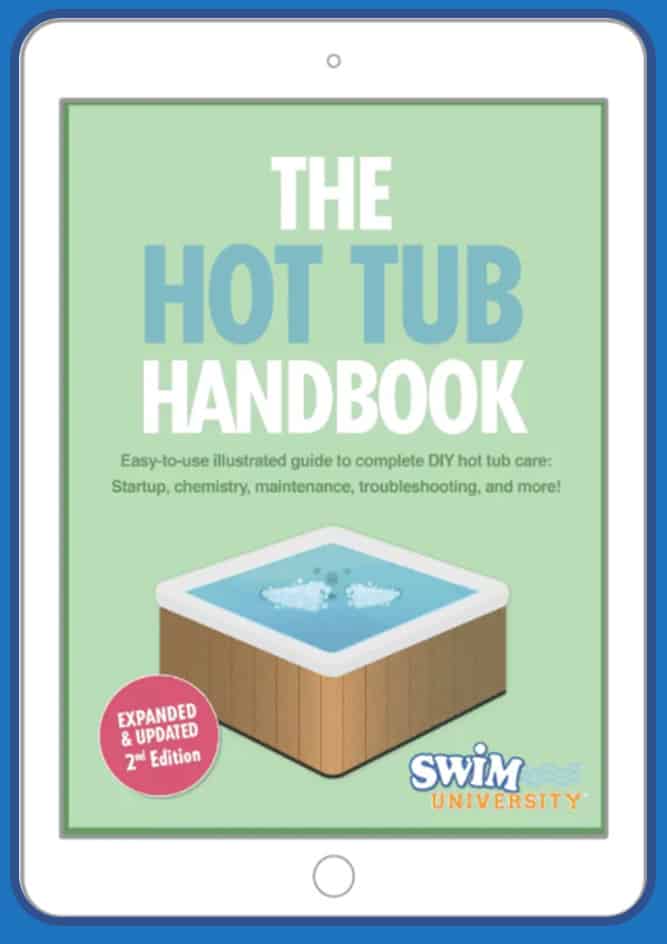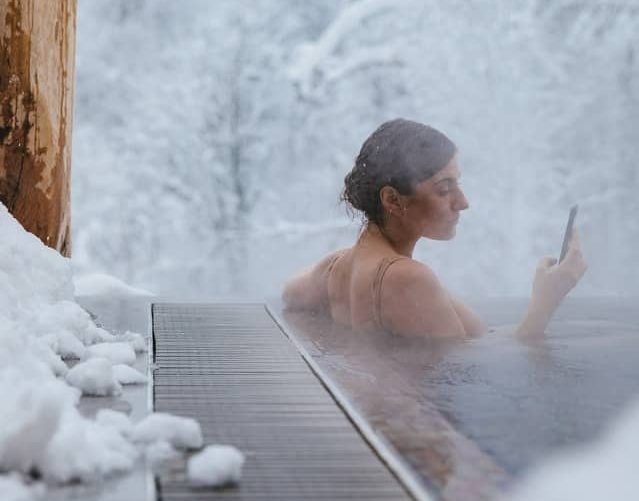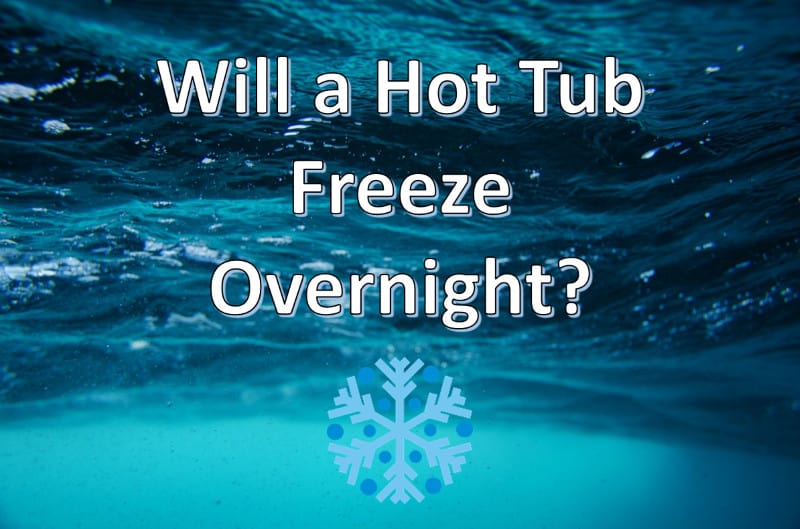Will a hot tub freeze overnight?
A hot tub will not freeze overnight. If there’s a power loss, it takes between 24 and 36 hours before freezing occurs. If the hot tub is well insulated and the cover remains in place, it could take a week before the hot tub starts to freeze up.
Stop wasting time and money with hot tub maintenance and confusing water chemistry! The Hot Tub Handbook and Video Course will help keep your hot tub balanced, sanitized, and crystal clear all the time.
Check out my list of high-quality hot tub products to help keep your hot tub clean and running great all year long!
I recommend a digital floating thermometer for your hot tub for more accurate temperature readings.
There’s no better way to rest after a long day of work than relaxing in a hot tub.
Winter is probably among the best moments where you enjoy the warm water while everyone else is freezing.
Winter has some challenges for hot tub owners despite being the best hot-tubbing season for the majority of the people; everyone fears that their system might freeze overnight.
In this article, I’ll talk about freezing hot tubs.
Let’s get started!
Will A Hot Tub Freeze Overnight?
No, your hot tub will not freeze overnight. Freezing in a fully insulated hot tub will require temperatures to fall below 28 degrees Fahrenheit and stay for about 36 hours. Even at such low temperatures, the pumps will still be working, and water will circulate through the pipes, decreasing the probability of freezing.
Experts advise that the only possibility that a hot tub can freeze overnight is when the water circulation stops and the power is turned off for a significant period of time.
Otherwise, a reasonably insulated hot tub with a cover will not freeze for a few days after a power outage.
In such a situation, freezing will take at least three days.
How Long Will It Take for a Hot Tub to Freeze Without Power?
Your hot tub will go for three days in the winter without the risk of freezing after power loss. But the cover has to be appropriately locked in place. This duration is based on temperatures between 102 and 104 degrees before the power loss. Do not open the cabinet door or the cover after the power loss unless necessary.
The duration suggested above is not standard across hot tubs. There are models with better insulation intended for regions that experience extreme winter temperatures.
Such designs can go for over seven days without freezing after a power loss.
At the same time, the presence of the external drains increases the risks of hastened freezing of the hot tub components because heat loss will occur faster.
The initial temperatures and the hot tub location will also determine the duration it might take for the water to start freezing after a power loss.
The critical point is that the most significant energy loss occurs at the water surface. Therefore, prioritize buying a quality hot tub cover as the winter approaches to minimize heat loss from the surface.
Check your current cover thoroughly to ensure that it is not ripped anywhere and if you notice such a fault, be sure to mend it before placement on the hot tub.
A good thermal blanket is perfect for retaining the water temperatures if you experience a power outage. Place the surface tightly to ensure that you trap enough energy to keep the water warm.
I recommend this Gekufa Spa Thermal Blanket.

Stop wasting time and money with hot tub maintenance and confusing water chemistry! Get Instant access to this easy-to-use book and video course so you can spend less time cleaning and more time soaking.
Learn MoreHow Do I Keep My Hot Tub From Freezing?
The best, simplest, and the most common way to keep your hot tub from freezing after power loss during the winter is to keep the cover tightly in place. If the temperature has fallen below 28 degrees Fahrenheit, the power might go beyond 24 hours. I advise you to add a thermal blanket and circulate the water manually.
When the winter is nearing, I advise you to set the hot tub at a maximum temperature of about 104 degrees.
At such levels, your hot tub will start at the highest temperature in case of a power outage.
A thermal blanket that floats on the water surface will work perfectly in maintaining the temperatures at the highest levels possible.
You should also run the jet pumps periodically to allow the water circulation to add more heat and keep the temperatures above freezing levels.
But if the jets are not operating, I would recommend stirring the hot tub water manually to ensure ice doesn’t build up.
In case of a power outage, you may place a small ceramic heater in the equipment area of the hot tub.
The last resort would be using a garden hose to drain the hot tub. Since there is no electricity to connect to the vac for eliminating the excess water from the bottom of the hot tub, use towels to soak and eliminate the excess water as much as possible.
If you don’t remove the water in time, thick pools will turn into thick ice blocks, causing severe damage to your hot tub.
You’ll also need to remove the side panels and open the screws on the connectors located at the underside of the control box to allow most of the excess water trapped in the pipes to drain out.
Will An Empty Hot Tub Freeze?
No, an empty hot tub will not freeze if it has been drained thoroughly and dried adequately. You should use a dry vacuum or a wet cloth to remove all the remaining water at the bottom of the hot tub. Adding antifreeze to the hot tub will keep the plumbing in good condition.
You should also suck the excess water in every jet individually.
After that, wipe every tub component keenly and keep the system covered appropriately before leaving it to stand empty.
Do not leave the filters in the hot tub. The hot tub will not freeze if properly dried.
After all, freezing relates to water, and proper draining of the hot tub will prevent any possible pipe freezing.
Any amount of water left in the hot tub and its components increases the possibility of freezing.
Therefore, always focus on emptying the water in the plumbing and not simply the shell.
Improper drainage will subject the plumbing fixtures to possible cracking and freezing.
Propylene glycol antifreeze– This product will be used in preventing freezing in your hot tub’s pipes. You should avoid using an antifreeze that contains Ethylene Glycol like the one used in cars because this is a toxic product.
What Temperature is Too Cold For a Hot Tub?
If temperatures drop below 0 degrees Fahrenheit in the wintertime, I would advise not using the hot tub unless it’s well insulated and designed for winter. In these frigid temperatures, keep the cover on at all times, high levels of filtration, and a temperature setting of 104 degrees Fahrenheit.
Most hot tubs do not have a fixed minimum temperature, and you should not be afraid if you come out of the house in the morning and find ice on your spa during the winter.
The only time your hot tub can be subject to the freezing risk is when there has been a prolonged power outage.
In such a situation, you’ll have to work extra hard to ensure that the water inside the hot tub and all the components keep circulating so that it doesn’t freeze.
No matter how much the temperature falls during the winter, freezing in your hot tub might not occur, especially if your model is designed for low temperatures because it has extra insulation.
You should not allow your hot tub to stand without power for more than 36 hours.
But the best soaking temperature depends on your personal preferences. It is always advisable to set your hot tub temperature slightly above the body temperature for the best experience.
However, set a lower level in summer because you will aim to cool off and relax.

Can I Leave My Hot Tub Empty in Winter?
Yes, you can leave your hot tub empty in the winter. Adding some antifreeze will allow the plumbing inside the hot tub to remain in good condition through the winter months when you’re not using it. Ensure the hot tub is completely dry and is fully covered.
Emptying the hot tub is advisable if you will not use it over the season.
The winterizing process thoroughly dries the system and components before the winter approaches.
Remember to turn off the power and place the lid tightly before leaving the hot tub empty over the winter.
You might not necessarily empty your hot tub for winter if the place you live does not experience extreme weather conditions. However, winterizing is necessary for those who experience extreme snowfall and cold temperatures in the winter.
For example, places like Texas have warm winters. Therefore, there might be no need to drain your hot tub for the winter.
On the contrary, Chicago, Montana, or Minneapolis experience extreme weather conditions that may force you to take a break from using the hot tub during the winter.
Nevertheless, you could be surprised to find that using a hot tub might be most enjoyable when surrounded by snow amidst the freezing weather.
As such, I would advise that you consider keeping yours empty if you won’t be around over the winter for a month or so.
Consider emptying the hot tub as the winter approaches if prolonged power outages occur during the winter.
Emptying the hot tub under such circumstances will be one of the surest ways to ensure your hot tub stays safe and damage-free.
I recommend the ULTCOVER Waterproof Hot Tub Cover to protect your spa during the cold winter months.
How to Keep Hot Tub Pipes From Freezing
The best way to keep hot tub pipes from freezing in the winter is to add antifreeze after emptying the hot tub. Antifreeze can remain inside the hot tub during the winter months. Proper insulation will also help in preventing hot tub components from freezing.
There are different practices you can take to keep the pipes from freezing.
These include draining the hot tub in the freezing weather, keeping the hot tub covered, circulating the water, and using a thermal blanket.
Draining the water during the freezing weather risks leaving some in the filter and plumbing components. Under extreme temperatures, the water will freeze and cause damage.
The cover and possibly a thermal blanket prevent heat loss from the surface.
If the cover is well in place, it will prevent the temperatures from falling below the freezing temperatures and affect the plumbing fixtures like the pipes.
Circulating the water will also prevent the pipes from freezing because the motors will heat up and add to the warmth of the hot tub water.
At the same time, the circulating water possesses kinetic energy that sets it in motion and delays freezing from happening.
If the hot tub pumps are not working correctly, you can buy a sump pump to keep the water circulating. You’ll only need to place the pump in the middle and connect to the power to allow it to circulate the water.
A ceramic heater can prevent freezing in the pipes if there is a power outage. Place the heater in the hot tub equipment and allow it to heat the water to above freezing temperatures.
What Happens If My Hot Tub Freezes?
If your hot tub freezes, the water forms an ice cube. The frozen water expands by about 9% of the original volume. The changing water volume can make important hot tub components crack, especially those enclosed like the pipes. At the same time, the standing water on the shell can cause cracking because of the changing volume.
Therefore, protect your hot tub by draining as much water as possible from all the components.
Draining and drying are much easier if you are connected to electricity because you can use the dry/wet vac and a submersible pump to get as much water as possible out of the system.
But if there’s no power, open the connectors on both sides of the heater tube, use a garden hose to drain the hot tub.
Will a Hot Tub Freeze Overnight: Conclusion

A hot tub cannot typically freeze overnight. It would take a temperature of below 28 degrees and at least 36 hours for the water to start freezing.
If there is no power and the cover is firmly in place, the hot tub can run up to three days before freezing. Indeed, retaining the cover firmly in place is one of the best methods to prevent freezing.
However, you can also add antifreeze, keep the water circulating, and use ceramic heaters inside the cabinet.
If an empty hot tub is drained properly, it will not freeze.
Therefore, you can leave the hot tub empty in winter and cover it tightly because it will not be subject to freezing if it is drained and dried correctly.
I hope this article and hot tubs freezing overnight was helpful.
Thanks for visiting spatoolkit.com
James Brockbank

Stop wasting time and money with hot tub maintenance and confusing water chemistry! Get Instant access to this easy-to-use book and video course so you can spend less time cleaning and more time soaking.
Learn More




